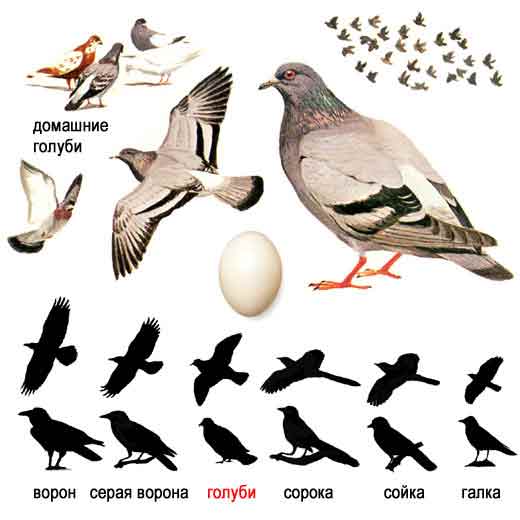The three western European Columba pigeons, though superficially
alike, have very distinctive characters.
The Wood Pigeon may at once be told by the white on its neck
(in adults) and wings.
The Rock Pigeon and Stock Pigeon are more alike in
size and plumage, but wild specimens of the former have a white
rump
and two well-marked dark bars on the wing, while the rump of the
Stock Pigeon is grey and its wing bars incomplete.
Feral pigeon (the same species as Rock Pigeon) is
highly variable, and indistinctly marked grey specimens with the
white rump missing,
can sometimes resemble the Stock Pigeon quite closely.
(Easy, isn't it?)
http://en.wikipedia.org/

Bydue - Rock Pigeon
http://commons.wikimedia.org/
Common
dove/Rock dove
Wild Columba livia are native to Europe, North Africa, and
southwestern Asia. It has later been introduced in Ethiopia, Australia
and
Pacific Ocean Islands. Feral pigeons are found worldwide, including
throughout all of North America.
Wild
rock doves nest in crevices along rocky seaside cliffs, close to
agriculture or open shrub vegetation.
Feral pigeons live in old farm buildings in rural areas. In cities,
the skyscrapers tend to take the place of their natural cliff surroundings.
The
rock dove has a dark bluish-gray head, neck, and chest with glossy
yellowish, greenish, and reddish-purple iridescence along its neck
and wing feathers. Females tend to show less iridescence than the
males. The bill is dark grayish-pink.
Two dark bands across the wings are seen in most pigeons, and one
bluish-gray band across the tail.
Rock doves and feral pigeons can be divided into a large number
of different phenotypes, or groups based on outward characteristics.
Some of these classifications are the blue-bar, blue checker, dark
checker, spread, and red phenotypes.

Bydue
- Rock Pigeon
Photo: © Mindaugas_Urbonas
Pairs
may be formed at any point during the year. These pairs are formed
for life.
Each bird works cooperatively on most aspects of reproduction and
young-rearing.
The male builds the nest, and the eggs are laid shortly after the
nest is finished. Both males and females incubate the eggs.
Eggs hatch approximately 19 days after being laid.
Pigeons
generally walk or run while bobbing their heads forward and backward.
They fly with a steady and direct path.
Pigeons are most often seen during daylight, seeking cover at night
and in during the heat of the day, according to the climate.
They flock while roosting, sunning, and feeding, but no play has
been observed.
In the nesting territory, both sexes are aggresive, pecking intruders
on the head.
Rock
doves feed in the early morning and in the mid-afternoon on the
open ground. They eat mainly seeds.
Studies of pigeons in a semi-rural part of Kansas found that their
diet includes the following: 92% corn, 3.2% oats, 3.7% cherry,
along with small amounts of knotweed, elm, poison ivy, and barley.
In cities, feral pigeons also eat popcorn, cake, peanuts, bread,
and currants.
Text
by By Jennifer Roof, from http://animaldiversity.ummz.umich.edu













